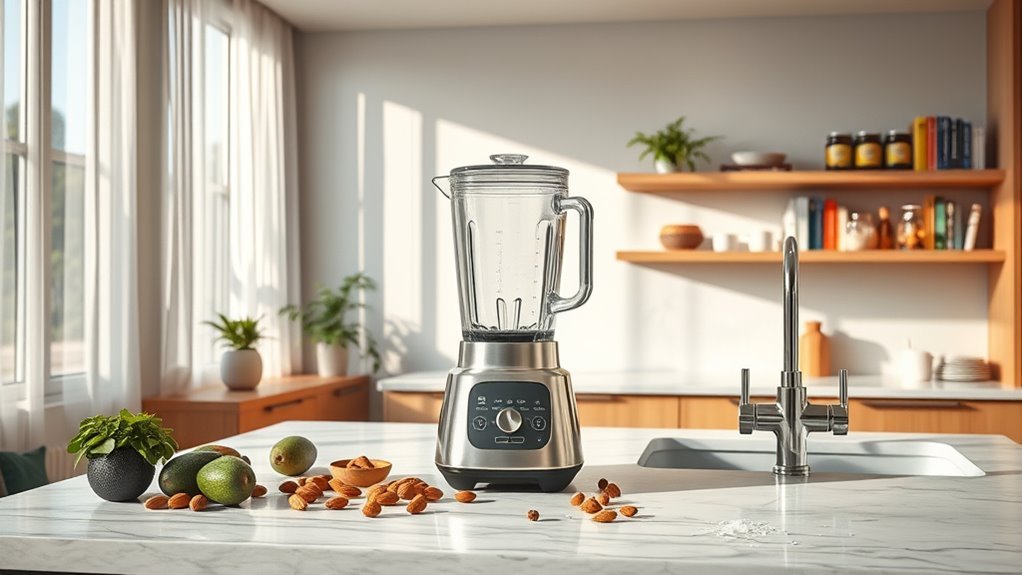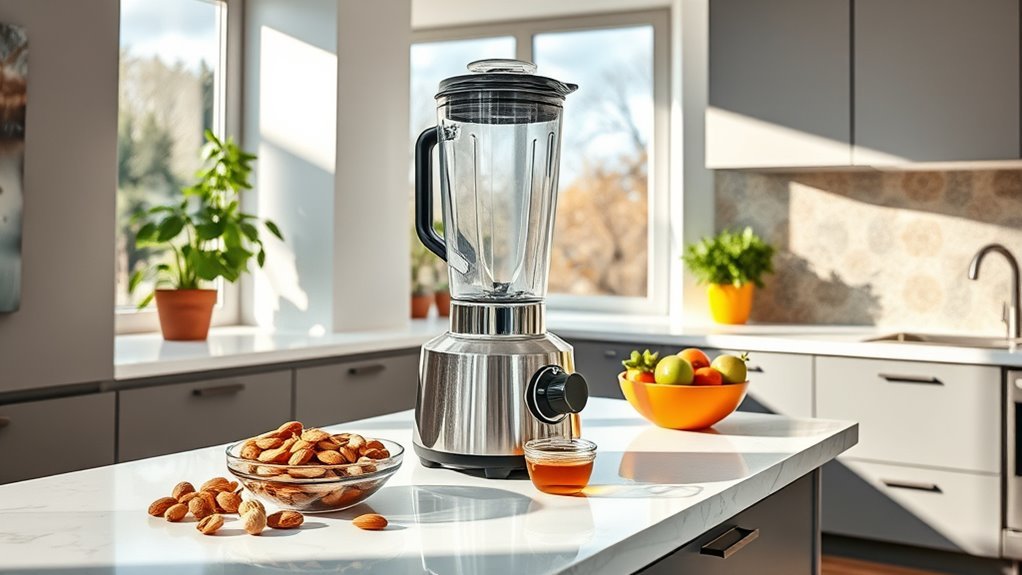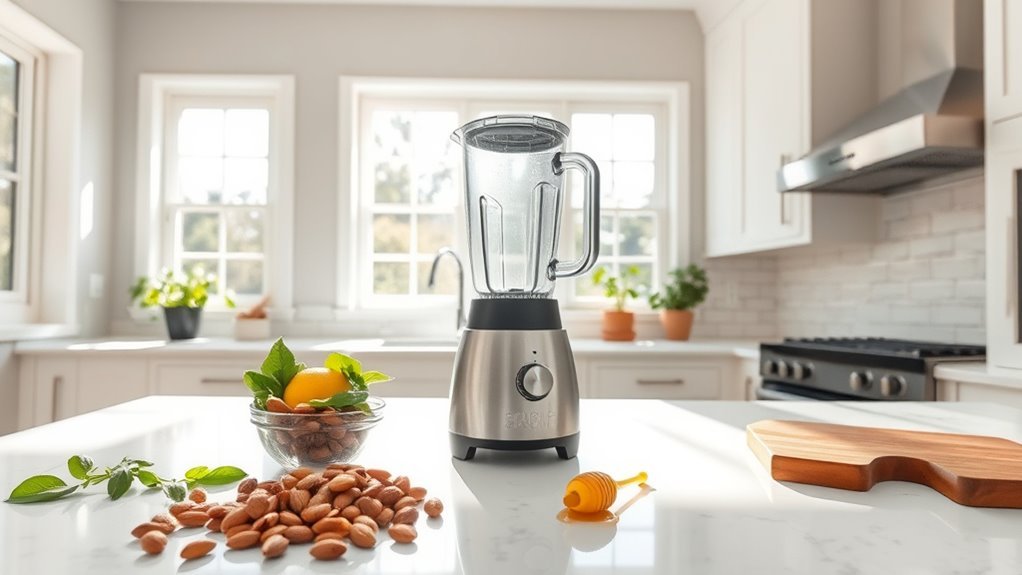Let’s master those blender speeds for perfect nut butter. Start at the lowest setting for one minute to break down nuts and release oils. Then, shift to medium speeds as the mixture gets crumbly, using regular pauses to scrape sides. Finally, crank it to high for the emulsification magic – but keep that tamper handy. Temperature management is essential, so work in 30-45 second intervals. Trust us, the journey from gritty to silky-smooth is worth every careful speed adjustment.
Understanding Your Blender’s Speed Range

When it comes to crafting perfect nut butter, your blender’s speed range isn’t just a fancy feature – it’s your secret weapon.
Let’s decode what those numbers on your dial really mean for your nut-grinding success.
We’re looking at a scale that typically runs from 1 to 10, and each setting serves a vital purpose. Lower speeds give you precise control during blending, preventing that dreaded overheating while ensuring different nuts break down evenly.
Crank it up to higher speeds when you’re ready for that smooth consistency we all crave.
Here’s the real pro move: Start slow, then gradually increase your variable speed settings. This method’s perfect for transforming any nut variety into that creamy finish you’re after.
Think of it as conducting an orchestra – timing and control are everything. Additionally, using a high-performance blender can help achieve a smoother texture and more consistent results.
The Low-Speed Breaking Phase
Now that you’ve got your speed settings dialed in, let’s put them to work. The low-speed breaking phase is vital for perfect nut butter.
We’ll start by running your blender at its lowest setting for the first minute, allowing the nuts to release their oils naturally.
Watch as your nuts transform from whole pieces to a crumbly mess – that’s exactly what we want. Don’t rush this process. Keep the speed low and pause regularly to scrape down the sides. This prevents motor strain and guarantees every particle gets its turn at becoming creamy texture perfection.
Think of it as a warm-up phase. We’re teaching those nuts who’s boss, but gently. Once they’re broken down and starting to release their oils, we’ll be ready for the next phase. Remember, the high-performance blenders are designed to handle tough ingredients like nuts, making this process smoother and more efficient.
Transitioning Through Medium Speeds

After your nuts have fully broken down, it’s time to kick things up a notch.
We’ll shift through medium speeds to make nut butter that’s impossibly smooth and creamy. This critical phase enhances the blending process while maintaining perfect control.
Here’s why medium speeds are your secret weapon:
- They prevent clumping while gradually releasing oils, creating that luxurious creamy texture you’re after.
- They’re perfect for incorporating optional add-ins without disrupting your carefully crafted consistency.
- They cut total blending time to 5-10 minutes max, delivering superior results faster.
Keep adjusting speed gradually – we’re not sprinting, we’re building layers of smoothness.
Watch closely as your mixture transforms from broken bits to silky perfection.
High-Speed Emulsification Techniques
Since you’ve mastered the medium speeds, let’s release your blender’s full potential with high-speed emulsification.
For creamy nut butter perfection, we’ll need at least 1,000 watts of power – anything less won’t cut it.
We’re going to strategically increase speed while keeping those nuts dancing around the blades. Add a teaspoon of coconut oil – it’s your secret weapon for ultimate smoothness.
Keep your tamper handy; we’ll need it to push down stubborn chunks. Your food processor’s about to work overtime for 10-20 minutes while those natural oils release their magic.
Remember: patience isn’t just a virtue – it’s the difference between chunky disappointment and silky smooth texture. Trust us, this high-speed transformation is worth every minute.
Temperature Management During Blending

While your nuts transform into creamy butter, they’re generating serious heat – we’re talking up to 120°F from friction alone.
Let’s tackle temperature management to protect your blend’s texture and flavor.
- Start your high-speed blender on low, gradually increasing speed as nuts break down. This controlled approach minimizes excess friction.
- Use short blending intervals of 30-45 seconds, giving your machine brief cooling breaks. We’re not running a marathon here.
- When things get hot (and they will), add a splash of coconut oil. It’s your secret weapon for temperature regulation and enhanced creaminess.
Remember: your tamper is essential here. Keep ingredients moving to prevent hot spots and guarantee even blending.
Your nut butter’s perfect texture depends on mastering this heat dance.
Speed Adjustments for Different Nut Types
Each nut variety demands its own unique speed strategy – you can’t treat almonds like cashews and expect stellar results.
We’ll need to tackle harder nuts like almonds with a gradual approach, starting slow and building up speed for that perfect creamy texture.
Cashews? They’re the speed demons of nut butter making. We can crank up the blender right away and watch them transform.
For mixed nut combinations, we’re going to start slow to guarantee even distribution before ramping up.
Want chunky texture? Let’s pulse at low speeds – it’s all about control here.
Timing Your Speed Progressions
Because timing is everything in nut butter making, we’ve got to nail those speed changes like a professional conductor.
Let’s make delicious, silky-smooth results by mastering our speed settings and timing.
- Start low for 1-2 minutes to break down nuts evenly – rushing this step ruins texture.
- Shift to medium speed for 3-5 minutes while watching for clumping.
- Hit high speed for 2-4 minutes to achieve that dreamy creamy texture.
Monitor the blending process closely and adjust blending time based on your desired texture.
We’re looking at 10-20 minutes total, depending on your nuts and machine.
Remember to scrape sides and use your tamper when things get stuck.
Patient progression through these speeds is what separates amateur attempts from professional-grade nut butter.
Frequently Asked Questions
Why Isn’t My Nut Butter Getting Creamy?
We’ll need to blend longer, around 15-20 minutes, and make sure we’re using proper temperature control. Adding oil and adjusting processing speed can help achieve that creamy texture we want.
Which Food Processor Is Best for Nut Butter?
Among 1000+ food processors tested, we’ve found the Cuisinart 14-Cup leads for nut butter making, offering consistent results, easy maintenance, and durability needed for homemade recipes and nutritional benefits.
What Is the Best Blender for Smooth Nut Butter?
We recommend the Vitamix Propel 510 for smooth nut butter. Its powerful motor, narrow jar design, and multiple speed settings guarantee perfect blending while maintaining the nuts’ nutritional benefits.
Can Vitamix 5200 Make Nut Butter?
Practice makes perfect! We can confirm the Vitamix 5200 excels at making creamy nut butter, offering precise control and powerful blending to transform raw nuts into smooth, spreadable butter within minutes.

